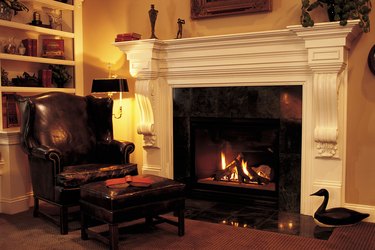 Chimney flues need to meet minimum required specifications. Image Credit: Comstock/Comstock/Getty Images
Chimney flues need to meet minimum required specifications. Image Credit: Comstock/Comstock/Getty Images
Building the flue for a fireplace must be done correctly to ensure the safety of the home's inhabitants. The setup for a flue depends largely upon the size of the fireplace and its openings. Flue design generally calls for a flue that is vertical to the ground, but in some homes it may be necessary to slope the flue to accommodate the home's design. Some considerations should be made before doing so.
Video of the Day
Slope
A fireplace chimney flue can be sloped, but it should only be done if absolutely necessary. The angle of the flue should be 90 degrees or directly perpendicular to ground level if possible. However, it is possible to come off of this vertical by as much as 30 degrees. This means that the flue can actually be installed at a 60 degree angle from the ground if necessary.
Starting Point
Aside from angle of the flue, the starting point for the flue, in terms of proximity to the smoke chamber, is also an important consideration. The flue's opening should be placed about 8 inches away from the top of the smoke chamber for optimal performance and safety. A rule of thumb when examining the chimney's flue is to look upward through the flue opening or downward from the top and ensure that you can see all of the mitered joints. This will ensure that smoke and other byproducts of the burning process will remain in the flue as required.
Bends
Flues will occasionally have a number of bends in them as well that will cause them to periodically slope at the elbow where the bend occurs. The number of bends and the angle of the bends will vary based on the total amount of space that the fireplace is offset from the outer wall of the house. The bends increase in quantity the farther they offset. This is necessary to create a gradual angling outwards toward the wall with as little slope as possible. Elbow bends typically range in angle from 22.5 to 37.5 degrees.
Codes
Before sloping or offsetting any chimney flue liner, you should check local building codes to determine what types of setups are allowable by law, according to the local community. While the typical standard configurations are generally allowable in many communities, your local municipal office may have additional information or stipulations that you need to take into consideration.







































